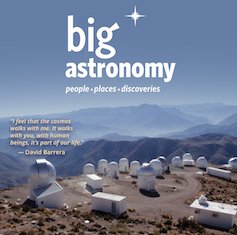Big Astronomy Toolkit - Main Page & Manual (English and Spanish)





- Adult, Child, Teen
- 03/09/2020
The Big Astronomy planetarium show features the people behind the science of modern large astronomical projects, like the incredible giant telescopes located in Chile. Just like these large telescopes, amateur astronomers seek dark skies for sharing the wonders of the universe with their communities. The topics featured in the Big Astronomy show also form the basis of our latest Outreach Toolkit! A classroom edition of the Educator Guide is also available.
Activities in this toolkit include models of the Milky Way Galaxy, light pollution demonstrations, and legends from around the world.
En español, abajo!
NEW! Adapations for blind and low vision (BLV) visitors, with DIY versions explained below.
- Please use and share: Best Practices for Welcoming B/LV Visitors
- DIY Adaptations for Blind and Low-Vision Visitors: Accessibility options for some of these activities are detailed inside. See also this lively Video discussion about making astronomy activities and events more accessible in general.
- Download Full Toolkit Manual for Blind and Low Vision Visitors
- Plus a Video describing the adaptations and activities
Download the full manual! Some individual activities can be found in the list below.
- Galaxy Model: An umbrella gives galactic perspective.
- Clues to the Cosmos: Filters and the universe around you.
- Good Light, Good Night: How shielding lights makes a difference.
- Dark Sky Wheel: How dark are your skies?
- Astronomy for Everyone Banner: The people behind the science!
- Legends in the Sky: Constellations from around the world.
Classroom Educator Guides in English and Spanish
See the planetarium show in 360 and meet the people who bring us big astronomy:
www.bigastronomy.org/live
Last Update: Aug 19, 2024
Big Astronomy is a collaboration between Abrams Planetarium at MSU, Associated Universities Inc. (AUI), Association of Universities for Research in Astronomy (AURA), Astronomical Society of the Pacific (ASP), California Academy of Sciences, Peoria Riverfront Museum, Ward Beecher Planetarium at YSU, Atacama Large Millimeter-submillimeter Array (ALMA), Vera C. Rubin Observatory construction project, NSF’s NOIRLab facilities Cerro Tololo Inter-American Observatory (CTIO) and the international Gemini Observatory. Big Astronomy is supported by the U.S. National Science Foundation (Award #: 1811436)



